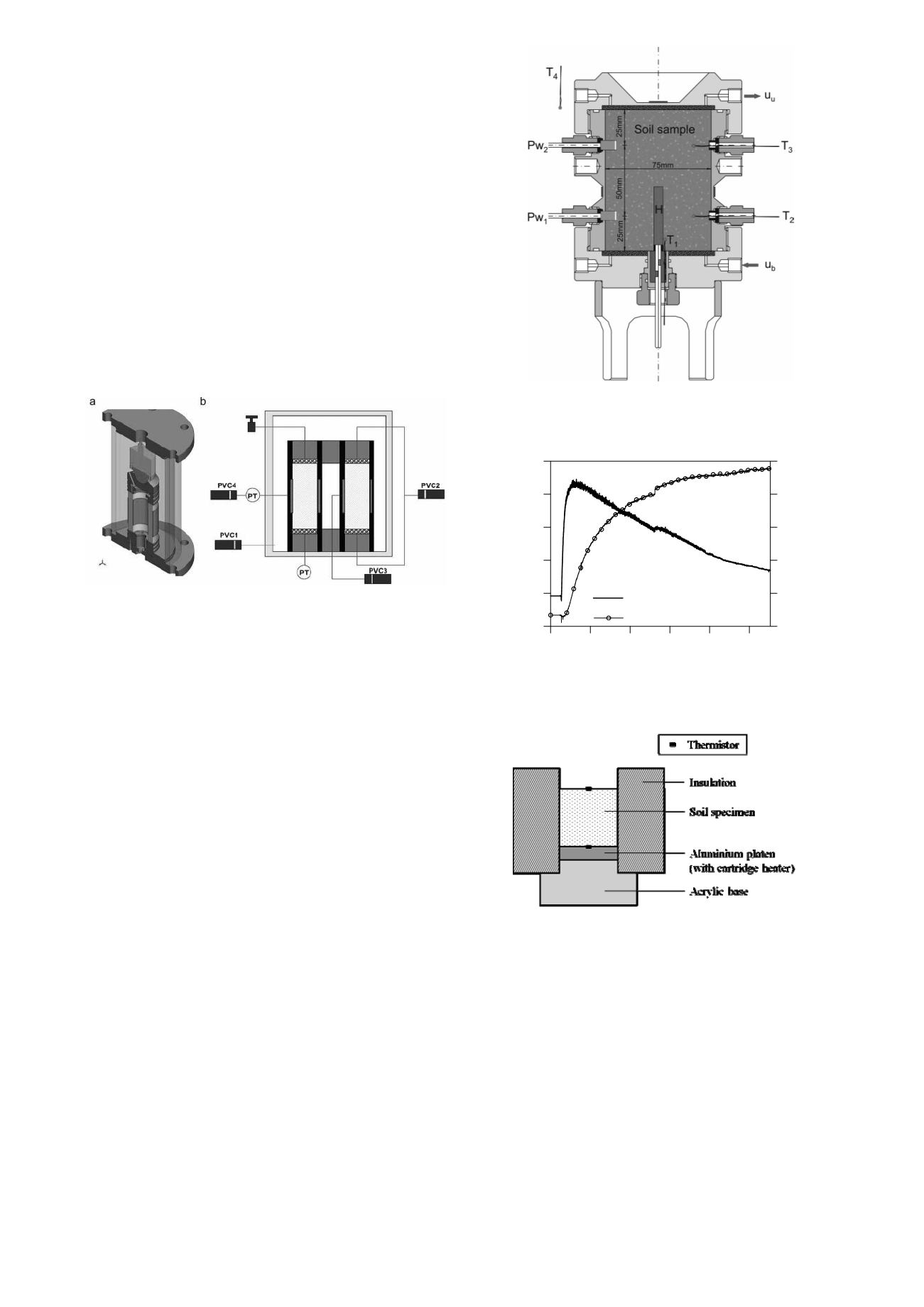
temperature affects the shear-, plasticity- and infiltration-related
soil characteristics. Zihms et al. recommended that more testing
should be done to better understand the high-temperature effects
on natural materials.
Monfared et al. presented an experimental work on the
thermal pressurization of Boom clay, a host geologic formation
for potential radioactive waste disposal in Belgium. Undrained
heating test was performed under in-situ stress state conditions
using a recently developed hollow cylinder triaxial apparatus
(Figure 3) that offers a short water drainage path out of soil
samples making it favorable for testing low permeability clay
and claystone samples. During the heating phase, the thermal
pressurization coefficient was determined from the change in
pore pressure and the undrained thermal dilation coefficient was
calculated from the measurement of volume change.
Subsequently, a cooling phase was induced under drained
conditions that allowed the determination of the thermo-elastic
dilation coefficient. The parameters identified from the tests are
important for modeling the thermal behavior of clay at the
radioactive waste disposal site.
Figure 3. Schematic diagram of hollow cylinder triaxial apparatus
(Figure 1 of Monfared et al.).
The study by Romero et al. also involves Boom clay. They
investigated the thermal and hydraulic behavior of Boom clay
by performing heating pulse tests on intact borehole samples
using an axisymmetric and constant volume heating cell (Figure
4) with controlled hydraulic boundary conditions. The study
focussed on the time evolution of temperature and pore pressure
changes along heating and cooling paths including pore pressure
development during quasi-undrained heating and subsequent
dissipation according to the applied hydraulic boundary
conditions (Figure 5). Romero et al. also performed a coupled
thermo-hydro-mechanical (THM) finite element analysis to
determine the thermal parameters by back-analysis and then to
simulate the experimental results. The study helped in the
identification of the main features of the hydro-thermal coupling
under test conditions.
Low et al. focused only on the thermal aspects and described
two methods to measure the thermal conductivity of soils. They
compared the performance of two laboratory-test equipments:
the thermal cell which uses a steady state method, and the
needle probe which uses a transient method (Figures 6 and 7).
Both the methods have their advantages and disadvantages. The
needle probe provides results quickly, and hence, is not affected
by moisture migration during testing. The thermal cell, on the
other hand, requires longer time, and hence, the results from the
thermal cell may be affected by moisture migration during
testing. The authors performed the tests on London clay samples
with the intent that these measurements will help in the analysis
and design of energy foundations. They noted that the thermal
cell approach is probably more suitable in the context of energy
foundations as it can be used to measure the thermal
conductivities of other relevant materials such as grout and
concrete.
Figure 4. Axisymmetric heating cell and transducers (Figure 1 of
Romero et al.).
95 114 133 152 171 190
Time (min)
0.8
1
1.2
1.4
1.6
1.8
Pore water pressure (MPa)
18
22
26
30
34
38
Temperature (ºC)
heating phase
Pw
1
bottom 25 mm
T
2
bottom 25mm
Figure 5. Time evolution of temperature and pore water pressure during
heating (Figure 3 of Romero et al.).
Figure 6. Thermal cell for thermal conductivity measurement (Figure 2
of Low et al.).
Xiong et al.
developed a finite element software, SOFT, to
simulate the THM behavior of soft rock. They simulated
drained triaxial tests performed on soft rock and a field heating
test performed by the Mont Terri underground laboratory in a
soft rock known as Opalinus clay. The authors simulated the
thermal heating isotropic drained triaxial test on soft rock as a
boundary value problem with different values of
overconsolidation ratio (OCR) and observed that the thermo-
mechanical behavior of the soft rock depends on OCR. They
simulated the field test with 4275 cubic iso-parametric elements
using back-calculated model parameters obtained from a
separate simulation of laboratory tests performed earlier on
Opalinus clay. Xiong et al. studied the evolution of the
temperature, excess pore pressure, and strain fields as functions


